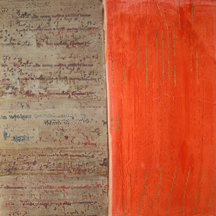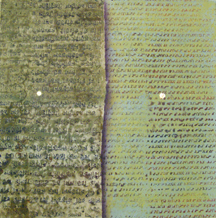BACK TO CONFERENCE SCHEDULE
Dennis Olsen
President, Santa Reparata International School of Art
Via San Gallo, 30
Florence, Italy
Tel: ++39 055 462-7374
Web: http://www.fionline.it/santareparata/
Email: dolsen@santareparata.org
Technical Demonstration: “Water-Based Monoprinting”
Over the past twenty years I have developed a unique process of monoprinting from PlexiGlas plates utilizing watercolor, oil based lithographic colors, computer generated polymer plates (Solarplates), and a variety of source materials ranging from codes and cryptology to cosmic diagrams and universal scripts. I will demonstrate with great specificity the nuanced and flexible nature of my methods. Though my process consists of many steps and requires a degree of research and preparation, the basic technique of watercolor monotype is relatively simple. I emphasize the spontaneous nature of the medium, but remind viewers that works of great precision can be made with these methods. Nothing about the process determines whether abstract or realistic work should result. Subsequent to my workshops and demonstrations most viewers are able to work on their own and to alter the basic process to their own ends.
I will begin my presentations with a brief talk about my prints using examples that I will present. It is essential that viewers see the prints before I show and talk about technique in order that they might understand my conviction that ideas drive the technique and make continual demands for more inventive solutions to aesthetic problems. I then discuss my materials so that viewers might make appropriate acquisitions in order to try some of these methods on their own. I discuss the differences between the use of watercolor on PlexiGlas as opposed to traditional watercolor on paper, and I point out with examples the particular benefits as well as some drawbacks to the use of watercolor on plastic.
I evaluate the advantages of oil based lithographic colors to achieve effects not possible with watercolor, and I refer to the original prints that I bring with me to show specific examples of the lithographic inks. Showing examples from my portfolio and on my laptop computer, I discuss my method for producing photo-mechanical plates from scanned images and other computer generated materials. I show examples of positive and negative transparencies as well as the polymer plates that I will use in the demonstration.
On several plates I demonstrate a variety of painting techniques that can be achieved using brushes, rollers, stamps, blotters, frottage, watercolor crayons, polymer plates, and airbrush. This section is the most “hands-on” and provides very specific information about how watercolor reacts in different situations, and why it is my medium of choice. Using two P-95 Plexi plates
All of my monotypes are made using three 1/8”thick plates of the same dimension; two are the so-called P-95 PlexiGlas (non-glare), and the third (used for the lithographic colors) is standard shiny acrylic. I bring to the demo two watercolor plates already developed, but not finalized. This allows me to work with a substantial and complex image without the need to hurry the process. I leave the plates unresolved so that I can finish them in front of the viewers, but not bore them with the often slow process of drying. This process is always done on a light table, an essential piece of equipment that allows me to see the true colors on the plates, and to work on one plate over another.
When the two primary watercolor plates are completed, I then begin the third plate that will carry the lithographic colors. Using off tint base and various colors to achieve transparency, I demonstrate how I roll the entire surface of the third plate, and use a variety of tools such as rags, Q-tips, and brushes to remove areas of this plate. Finally, the three plates are printed one after another on an etching press using dampened paper. The final print is then placed in blotters or pinned up to dry.
Essential Equipment in the studio
1. etching press and blankets
2. soaking tray
3. light table approximately 20” X 30”
4. lithographic off-tint base and some colors
5. litho roller
6. solvent
Materials I bring to the demonstration
1. tube watercolors
2. brushes
3. sponge brushes
4. templates
5. polymer plates (Solarplates)
6. ink jet transparencies
7. “Pictorico” film for ink jet printing
8. rollers and brayers
9. Caran d’ache watercolor crayons
10. printing paper
11. tissue paper
12. Lexan printing template
13. handouts with list of colors and suggested materials
 DENNIS OLSEN is the President, Santa Reparata International School of Art in Florence, Italy and a Professor of Art at the University of Texas, San Antonio where he teaches drawing, printmaking and digital imaging. He received his MA and BA degrees from the University of California at Los Angeles. He is a past recipient of a Fulbright Fellowship to study printmaking in Italy and received a Partners of the Americas Fellowship to Peru. His work has been exhibited internationally, in one-person, group and competitive exhibitions. He has directed the University of Texas San Antionio Printmaking in Florence Program since 1982.
DENNIS OLSEN is the President, Santa Reparata International School of Art in Florence, Italy and a Professor of Art at the University of Texas, San Antonio where he teaches drawing, printmaking and digital imaging. He received his MA and BA degrees from the University of California at Los Angeles. He is a past recipient of a Fulbright Fellowship to study printmaking in Italy and received a Partners of the Americas Fellowship to Peru. His work has been exhibited internationally, in one-person, group and competitive exhibitions. He has directed the University of Texas San Antionio Printmaking in Florence Program since 1982.


REPRODUCTIONS: Two watercolor monotypes 20" x 20" year 2004
 DENNIS OLSEN is the President, Santa Reparata International School of Art in Florence, Italy and a Professor of Art at the University of Texas, San Antonio where he teaches drawing, printmaking and digital imaging. He received his MA and BA degrees from the University of California at Los Angeles. He is a past recipient of a Fulbright Fellowship to study printmaking in Italy and received a Partners of the Americas Fellowship to Peru. His work has been exhibited internationally, in one-person, group and competitive exhibitions. He has directed the University of Texas San Antionio Printmaking in Florence Program since 1982.
DENNIS OLSEN is the President, Santa Reparata International School of Art in Florence, Italy and a Professor of Art at the University of Texas, San Antonio where he teaches drawing, printmaking and digital imaging. He received his MA and BA degrees from the University of California at Los Angeles. He is a past recipient of a Fulbright Fellowship to study printmaking in Italy and received a Partners of the Americas Fellowship to Peru. His work has been exhibited internationally, in one-person, group and competitive exhibitions. He has directed the University of Texas San Antionio Printmaking in Florence Program since 1982.
